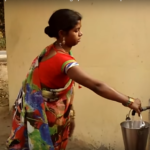Thousands of people have gathered in Verwada, Badhwani to celebrate the newest festival in Madhya Pradesh - the festival of Rani Kajal Mata, an ancient, indigenous deity.
Thousands of people have gathered in Verwada, Badhwani to celebrate the newest festival in Madhya Pradesh - the festival of Rani Kajal Mata, an ancient, indigenous deity. The deity, a sacred rock, is the guardian goddess of the Pata tribe that resides in Badhwani, the northernmost district of Madhya Pradesh, bordering Rajasthan.
It was the first time that such a festival, celebrating the goddess and the indigenous way of life, was organised festival was organised by Jagrat Adivasi Dalit Sangathan. To join in the celebrations, a crowd of over 5,000 indigenous people from around Badhwani and it's neighbouring districts came together. Rani Kajal Mata is the protector of an ancient tribe in Madhya Pradesh. The community prays to her in times of trouble.
What troubles the tribal residents of Badhwani that they are now summoning their protector? "We've lost our indigenous seeds. Our water and jungles are disappearing," says Bilatibai from Verwada village of Badhwani. Bilatibai and her community's concerns are valid and supported by a study which places Badhwani in districts which are ‘very highly vulnerable’ to climate change, particularly with regards to availability of water. Madhya Pradesh is home to 14.69% of India’s adivasi or tribal population out of the total 104 million adivasis across the country.
Badhwani, primarily a tribal district, lies in the valley from where the river Narmada flows. Large swathes of the district's settlements and forests have been submerged due to the Sardar Sarovar Dam--one of the highest dams in the world. For instance, this report claims that several tribal forest villages have been completely submerged under Narmada's water causing displacement of both the communities residing there as well as destroying the green cover of this largely arid area. Also, putting dams along the river's course has caused stagnation of the water making it saline and also hampering the natural process through which fertile sediments would be deposited on the banks, increasing soil fertility. The alkaline saline water is unsuitable for irrigation and has rendered fields barren. This has severely affected the tribal communities in the region whose primary occupation is agriculture.
Through the festival and invoking goddess Rani Kajal Mata, the tribals elders of Badhwani wish to remind the younger generations about their dependency on nature and the need to protect it. It is also an attempt to revive the fight to regain jaal, jungle, zameen (water, forests and lands) "Our culture worships nature and its elements as divine. Over the time, we've replaced these gods with others and have forgotten the importance of nature in our lives. But we depend on the environment for food, livelihood and shelter," says Pawan Solanki, a tribal from the region who is also a Video Volunteers' Community Correspondent. Pawan and his community's concerns are validated as the impoverished rural communities, which depend on ecology more directly are likely to be affected more by deteriorating environmental conditions and factors that limit the availability of natural resources.
The community elders are feeling the impact of environmental degradation through development projects on their livelihood and therefore their identity. They are trapped in cycles of famine and debts. As a result, the younger generation is forced to undergo distress migration across the country and often work in badly paid hazardous jobs. The migration has also diluted their individual tribal identities, causing them to become distanced from their sustainable way of looking at life. "Due to migration our brothers and sisters go to cities and lose pride in their individual identity. They assume that being tribal is inferior," says Pawan. The festival celebrates this unique identity through arts and culture, stories that reflect the generational oral history, and prayers invoking the ancient goddess.
The gathering also serves as a meeting point for the thousands of people from various villages across Badhwani, who are fighting for their rights under the environmental and social movement Narmada Bachao Andolan (Save Narmada Movement). "The people come here for three days. They congregate and discuss new strategies, learn about new solutions from each other and learn about the overall progress," says Pawan. While elders have been active in the movement, the youth's interest in the movement has been fading. Pawan feels that this festival can become a starting point to get more youth on the board to join the community's fight to protect and preserve the environment and hence, their identity.
Article by Sangeeta Rane
Livelihood at stake in Chatra
The matter is serious - in Jatrahi village under Sikid village council of Chatra Block, Chatra District of Jharkhand, 25 families of Bhuyan community were living for 70 years and they are asked to relocate.
Tribal in Kalahandi, Gathered to Protect Kalapat and Khandualmali
The Community Correspondent (CC) Satya Banchor, in this video is showing us a public gathering, where eminent social workers such as Medha Patkar of Narmada Bachao Aandolan are addressing the crowd of villagers, about their environmental rights.

